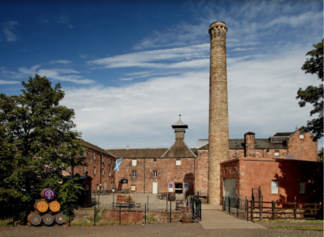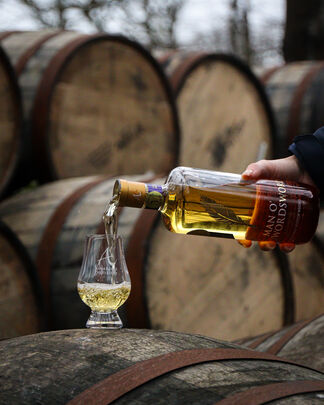Annandale Distillery
Producing Whisky Again After a 100 Year Break
Annandale Distillery sits in the Lowlands region of Scotland, just 15 minutes North of the England/Scotland border. Not far from Gretna Green. It was first established in 1836 by George Donald, an Elgin-based excise officer who named the site after the valley it sits in. Using water from the Guillielands Burn for cooling and power, and from Middleby Burn for the whisky, the Lowland site functioned for nearly a century, once capable of making 28,000 gallons of spirit annually. It closed in the 1920's. The buildings were used as a farm and for a time by Provost porridge oats breakfast cereal brand as a production line. But before long the buildings fell into a state of disrepair.
Until 2007 when a husband-and-wife/business partner team fell in love with the property and set out on a 17.5 Million Pounds restoration journey to revive Annandale Distillery.
A Bit of History
The distillery was originally built in 1830 by George Donald, a former excise officer from Banff in Aberdeenshire. He chose the site as there was a pre-existing clearing in the woods with a plentiful water source, which was essential for both whisky production and to power the mill water wheel for grinding the malted barley. Peat bogs were just 3 miles away. The damp and mild climate was perfect for the maturation of the whisky, and a bonded warehouse was built on the site. Iconic pink sandstone was locally quarried to build the distillery and dunnage warehouse. The region is famous for this uniquely coloured stone, which can be seen in many other significant buildings nearby.
Annandale Distillery was opened in 1836, making it one of the earliest 'legal' whisky distilleries in Scotland. The Donald family lived in the farmhouse to the rear of the distillery during their time here. George, his wife Margaret, and their children, ran the distillery for almost 50 years. Margaret Donald was said to be very hands on, working as a still (wo)man and firing the stills over an open coal fire. It would have been a very labour-intensive job.
George Donald died in 1883 and the distillery was transferred to John Sykes Gardner. John was a wine and spirits merchant from Liverpool. He updated the distillery with new machinery and buildings over the next 10 years.
Johnnie Walker and Sons bought the distillery in 1893, it is believed they used the spirit from Annandale Distillery as a source of peated whisky for their blends. The iconic Charles Doig pagoda roof was added to the distillery in the 1890s. This specially designed structure is an iconic part of many distilleries in Scotland but is one of only five known originals to survive.
Whisky production at Annandale Distillery ceased shortly after the end of WW1 in 1918, due to the difficulties in maintaining production. The once abundant resources that had drawn Johnnie Walker to buy the distillery had started to disappear, and the global market for whisky was crashing as a result of the many post-war temperance movements. Johnnie Walker kept the distillery buildings and site until 1924 but dismantled and removed most of the machinery and some parts of the main building. The lease was then passed on to the Robinson family, who were farmers. Until it was acquired by the current owners in 2007.
Annandale 2.0
Professor David Thomson, an expatriate Scot, was looking for a project that would anchor his life back to his native Scotland while Teresa Church was keen to find work that supported her enduring passion for restoring old buildings. Annandale ticked all the boxes and so in 2007 they began an extensive restoration project. Professor David Thomson is co-founder of Annandale distillery in Dumfriesshire, and worked as a cereal chemist and university lecturer in sensory and consumer science before establishing Oxfordshire-based Mathematical Market Research (MMR) - claimed to be the largest privately-owned market/consumer research agency in the world.
It took a while, but they breathed new life into Annandale Distillery; whilst making use of the historic building and what was left of the site. The roofs of the main building and the bonded warehouse were in a state of complete disrepair. Research revealed that the original slate was from North Wales, and a good match was found and repurposed from a demolished building. The historic pagoda roof was in remarkable condition for its age and is one of only 5 original Charles Doig pagoda roofs left. The mash house section of the main building needed some precision engineering work to stabilise the structure of the building before renovations could take place. This involved the demolition of a section of wall in a state of near collapse. Luckily, the pink sandstone needing replaced could be sourced using what was left of a demolished building in Glasgow. This was from the exact quarry that the Donald family sourced from when the buildings were originally built in the 1830s.
The Princess Royal reopened the distillery on 10th September 2015 and now welcomes over 25,000 guests every year.
Annandale Whisky
Whisky flowed from the stills of Annandale again on 3 November 2014. The whole production setup was built under the guidance and supervision of the late, great Dr. Jim Swan (see Blog entry The Einstein of Whisky), who had known Thompson since the mid-1980s after they'd met at a sensory conference in London. Swan advised the use of traditional wooden washbacks and helped source high-quality casks. The distillery produces both peated and unpeated single cask, single malt bottled at cask strength, with names inspired by Scottish heroes. The peated whiskies are bottled under the Man O' Sword name after King Robert the Bruce, Scotland's warrior king and the 7th Lord of Annandale, while unpeated whisky is presented as Man O' Words after Robert Burns, the Scottish Bard (and once an exciseman in Annandale). There was also an Outlaw King Blended Scotch whisky released in 2019 to celebrate the Netflix film of the same name.
Annandale whisky is all single cask bottlings. Meaning that every batch is different and dependent on the cask used. So tasting notes will vary slightly from batch to batch.
I got a bottle of the Man O' Swords Founders Selection - Sherry Cask 2017/2023. So somewhere between 5 and 6 years in the cask. It cost a tad under 80€. Not bad for a single cask, single malt whisky. This is their peaty whisky, but don't expect an Islay! This is really quite smooth.
On the nose there are creamy-sweet vanilla notes, apple, and ashy smoke.
It tastes wonderful with strong notes of apple, tropical fruits, and nuts all mixed with smoke.
The finish is long and smooth, again with a lingering smoky note.

